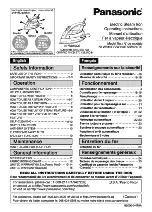
Clayton Steam Generator model EO-100-1
PAGE 52 / 70
Instruction Manual, doc.nr.: MAN18206 Rev A PSC
•
Use preferably a 20 mm hose
(large garden hose which can supply water at a minimum of 20 l per
minute)
and insert the discharge of the hose
(no nozzle)
through the stack opening and under the inner
heater cover. Move the hose discharge to direct the water evenly over the entire top surface of the
heating coil.
•
Soot removal will be obvious by the dark color of the water draining into the trough from the burner
opening. When water runs clear, it will indicate that the soot has been removed.
•
When the heating unit has drained, operate the blower for a few minutes to remove water which may
have collected in the volute and air damper.
•
After washing, it is preferred that the unit stand overnight to drain thoroughly before the burner is
replaced. If it is necessary to start the unit as soon as possible after washing, the burner should be
operated with short interval firing several times before it is put back into service under full operation.
It is suggested that four firing periods of 1/2 minute each
(spaced at three minute intervals)
be used to
gradually dry out the combustion chamber and thus avoid any refractory deterioration.
9.2.3
HEATING COIL REMOVAL
-An authorized Clayton technician should supervise this operation
Removal of the heating coil from the burner base is done as follows :
•
Remove inspection covers and remove thermocouple.
•
Disconnect piping from heating coil inlet and outlet connections. Remove pipe fittings from outlet
connection located at bottom of coil. On oil fired units, remove soot blower pipe fittings. Remove
capscrews which attach separator to bracket on coil.
•
Disassemble removable section of exhaust stack above heater cover
[1]
. Remove upper and lower
clamb band
[3 and 6]
. Remove outer and inner heater cover
[1 and 2]
. Unscrew sheet metal screws
from outer shell and remove both halves.
•
Remove hold-down bolts
[17]
located at the bottom of the shell at each support channel and lift coil
and shell assembly complete from burner base.
9.2.4
HEATING COIL REPAIR AND INSTALLATION
-An authorized Clayton technician should supervise this operation
•
Hydrostatically test coil for leaks. If suitable welding cannot be made, coil must be replaced.
•
To replace a coil, proceed as follows :
•
Seal vent opening around top of burner base with masking tape. This will prevent insulation material
from entering the base through this opening.
•
Mix castable insulation with water to a consistency equal to an ordinary concrete mixture. Fill coil
recess to 90 mm
(fig 8.9)
in height. The coil discharge line is to be used as a locating device in the
burner base, in combination with the coil spacers to center the coil. Lift and position coil on the
burner base and allow coil to settle into the insulation. Secure coil to burner base with the hold-down
bolts. Remove masking tape seal from vent opening when insulation dries sufficiently.
•
Install outer heater shells, front and back and inner and outer heater covers. Remound upper and
lower clamp bands. Remound removable section of the exhaust stack.
•
Replace capscrews which attach separator to bracket on coil. If oil-fired unit, connect sootblower pipe
fittings. Connect all in- and outlet connections
WARNING
:
Some countries
(or local rules)
do not allow that the washing water is drained to the
sewer. Please verify if special rules are applicable for your country or region. If so, consult a
specialized company for neutralisation and removal of the washing water
















































